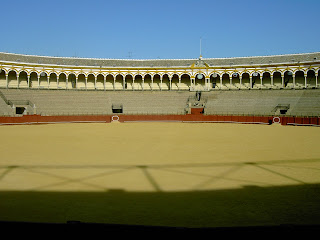The palm fronds swayed in the cool breeze while the sun’s rays warmed my back. No, I didn’t make the journey back to
The cathedral
I am not exaggerating when I say that this is a grand cathedral; it is the largest Roman Catholic cathedral in the world, with the central nave rising 138 feet above the ground, and it also houses the largest altarpiece. Almost eclipsing all of this architectural grandeur, however, is the tomb of Christopher Columbus, hoisted by four Spanish Kings above their shoulders.
The next stop on our tour of
The Islamic influence is striking here, with a dizzying array of fountains, geometric arches, and large courtyards seen throughout the sprawling grounds. One of the most serenely creepy places in the palace was the Baños de Doña María de Padilla, which is a tank for rainwater collection.
Nicest rainwater tank ever
The last big stop during our stay in
A guided tour was required to explore the bullfighting arena and its museum, which actually ended up being pretty cool, especially since the tour was bilingual and we all got to get in the “Spaniards” group of the tour and leave all the other American tourists behind! The most memorable part of the museum was the bull heads mounted on the wall, ears cut off as rewards for the matadors with whom they performed a deadly tango.
The loser of the tango
On Sunday we took the high speed AVE (topping out at about 180 mph) to the cold of





No comments:
Post a Comment